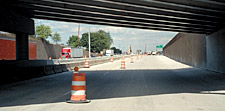Design and Construction Strategies

As our highway infrastructure ages and congestion increases, transportation agencies must find ways of building and reconstructing roads and bridges while limiting impacts to the traveling public. Several design and construction strategies and technologies can be used to save time and cost, and provide a better, safer driving experience during construction.
Accelerated Construction
Accelerated construction uses various techniques and technologies to help reduce construction time while enhancing/maintaining safety and quality.
Coordinating Road Projects
Coordination of road projects between transportation agencies, utilities, and other agencies that need to do construction in the public right-of-way can result in benefits such as significant cost savings, earlier identification of project impacts and greater ability to reduce and manage traffic disruptions from road work, and better quality road surfaces.
Design-Build
Design-Build combines design and construction into one contract and coordinated process, speeding up project delivery and leveraging resources and innovation. Safety and mobility can benefit when work zone considerations are explicitly included.
Night Work/Off-Peak Work
Night work/off-peak work involves scheduling work at periods of lower traffic volumes, to reduce traffic disruption, as well as worker exposure to traffic and driver exposure to work zones.
Positive Protection
Positive protection can reduce the risk to workers and travelers with the use of devices that contain and redirect vehicles, reducing the risk of vehicle intrusion into the workspace.
Road Closure and Lane Closure
Road closure is an approach designed to eliminate the exposure of motorists to work zones and workers to traffic by temporarily closing a facility for rehabilitation or maintenance.
Additional Resources
- Use of Exposure Control Measures - Summarizes the various types of exposure control measures and discusses how each can improve the safety of workers and motorists in work zones.
- Highways for LIFE Program - FHWA program to accelerate the adoption of innovations that achieve longer-lasting highway infrastructure and the fast construction of efficient and safe highways and bridges. An article in the January/February 2010 issue of Public Roads describes the program and provides examples of projects that have benefited from the program.
- Presentations from Conference on Transportation Construction Management, February 10-12, 2009 - Held to discuss new challenges and solutions in successful transportation project delivery. An article in the July 2009 issue of Focus provides more information about the conference.
